- Duration:
- 18 minutes, 34 seconds
The Documentation Course: Beyond Drawing by Carter Hudgins and Amalia Leifeste
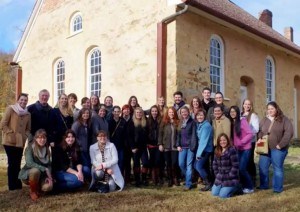
Behind the changed course numbers, deleted courses, new course, and revised course descriptions lay longer process. Deliberation stretched over several years and addressed questions familiar to all of us, centrally what should out students know and when should they know it.
This presentation summarizes the efforts of the Clemson University and the College of Charleston faculty to reimagine and revise its required first semester course titled, "Investigation, Documentation, Conservation " or "IDC". Carter sends his best regard and his apologies that a family obligation pulled him away from this gathering at the last minute. Forgiving Carter and hearing his voice and vision in this discussion ... I'll move on.
Thinking about the purpose and content of the IDC course began more than two years ago. It tied into the overall curriculum revisions that I mentioned, also shifts in faculty, the accumulation of incremental tinkering from over the years like we hear about in Rebecca's presentation, and also an opportunistic sensibility towards case study building.
This presentation first covers our evaluation of this core course, and then second I'll discuss the steps we've taken to implement the aspirations that we have for the course. As first step to evaluating IDC we needed to determine the goals and then set the content for the course, particularly in relationship to other first semester course. IDC plays a critical role in the first semester in terms of introducing the students to the work that preservationist do. Of course, also must recognize the diverse backgrounds, diverse preparations, diverse skills, and a wide range of technical abilities that arrive with each new class of students.
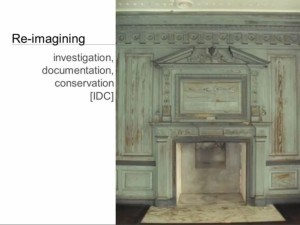
The iteration of IDC that I discuss today, the version that we will undertake for the first time this upcoming fall, we see as a large, albeit only first step, towards an elegant solution of how to integrate field work within the curriculum and enable students to gain skills in a suite of related technical abilities and ways of thinking. In other words, IDC is a work in progress which we hope to discuss with many of you and about which we welcome comments, recommendations, suggestions.
IDC occupies an important position in the first year curriculum for our MSHPs four semester program. It is, on one hand, a studio based course that introduces new students to the program studio culture. It is on another an introduction to field work, measure drawing, and the translation of pencil drawing to HABS standards, HABS compliant measure drawings. IDC is third, immersion into teamwork and the cooperative atmosphere that over arches the program.
The overall curriculum conducted in the two year course of study which our program has privileged field recording and documentation drawing to HABS standards since it's inception ten years ago. Accordingly, IDC has occupied a privileged position within the curriculum. Documentation methods, including field measurement and drawing, site mapping, redecoration of cultural resource, all these things occupy significant, some even argue out-sized, place in the curriculum.
In exploring the base line of IDC, we realized, among the faculty and with some outside reviews, that our operating premise was, and should remain, that you really can't know a building well and you can't intelligently know what to do with it until you have documented it thoroughly. We see documentation as a necessary first step in preservation processes, and therefore this is the central, critical skill that we very much wanted to emphasize within the curriculum.
What to sort out building phases, taking paint samples, interested in dendrochronology, from questions about use to puzzles about chronology, to first and final passes at creating reevaluation plans and post rehab management plans, documentation drawing are for us a first step.
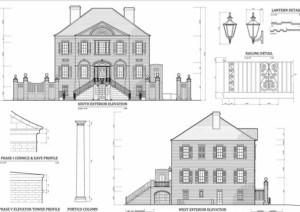
Baby steps. Several years ago, before my time with the program, the faculty expanded inspection and measure drawings from simply measure drawing, skill drawings, to incorporate also cultural landscapes in the analysis of interior finishes. This explanation of the course, which then became IDC, was the first step of moving the documentation course beyond drawing. These new components of the course were preservation perspectives that students applied later in their course of study, but that we began to feature in the first semester course. A review of the curriculum initiated about three years ago, suggested that these were steps in the right direction.
The initial feedback about the direction of the class came through a series of assessments that were undertaken. At that time our program took on around a programmatic reviews, some mandated by the College of Charleston assessment cycles, some required by accreditation review. The self study and reports from both internal and accreditation visiting committees - we posted three of them in fact - affirmed that the MSHP faculty sensed that the emphasis places on documentation was right, first of all, and also suggested that the merging in this introduction to multiple things, as well s drawing, in the first semester was a good step.
Faculty deliberation suggested, however, that while IDC effectively merged multiple introductions to portions of the curriculum into one course, it fell short of presenting the interdisciplinary nature of current practice. IDC, we also discovered, siloed from other first semester courses. For example, we found less intersection between out IDC and our American architectural course than we would have liked. The American architecture course is a one semester course inherited from Clemson School of Architecture that serves as an architectural history overview course.
Similarly, there was some breezy interaction between IDC and out course in historical building technologies . IDC, architectural history, and building materialism constructions therefore marched along parallel tracks within the first semester curriculum. We found that students applied a siloed approach to reading and understand historic buildings and their context.
We also discovered siloing internal to IDC itself. Student field work pursued architectural documentation, the documentation of interior finishes, and the documentation of landscape along these same parallel tracks. [inaudible 00:08:37] reports conveyed lots of data to project clients, but chapters observed these same boundaries as the sections that they were taught in.
Thus, the challenges we observed is to bring the components of IDC into a more interactive posture and in the process weave IDC into a more coherent introduction to what professionals encounter. The revised IDC course, which will have it's first run this fall, as I mentioned, doubles the number of credit hours from 3 to 6, and provides additional opportunity to weave observation and analysis into a layer, interdisciplinary approach to documentation and conservation.
The revised course, in general, encourages students from their first encounter with urban and rural places, to understand buildings as expressions of complicated, interrelated, cultural processes. The course employs field based investigation of a historic building in or near Charleston, to introduce and reinforce the linkages between field documentation, the investigation of historic building methods, and the survey of cultural landscapes.
We're in the midst of this experiment. We have envisioned changes to the curriculum, and this all will be implementing the course.
For this last portion of the presentation I'm going to give an example of where the course has been, I'll take you through the fruits of one IDC courses labors, and offer a brief preview of the next project that we'll be taking on in the fall.
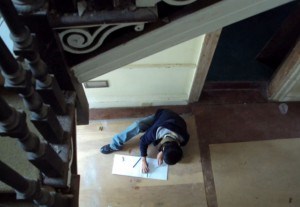
The current owner has energetically begun a rehabilitation of the house. She anticipates doing a great deal of the work herself, and though not antagonistic to suggestions and advice offered by preservationist, our program began involved in this project because of the concern of loss of historic fabric that grew from the piles of construction debris that were filling up the dumpsters of the property curb. It became critical to get what fabric remained documented at the interior of this building, which we knew was going to be protected at the exterior.
As I mentioned, students look at the IDC building through a series of lenses throughout the course of the semester. These perspectives remain legible in the final report. I'm going to walk through this final report and point out some places where we've started to bleed over into other courses little bit better, but also the room for forth that we see in the integration of this report.
The 2013 IDC report on 61-63 Smith Street, the house you just looked at, opens with a synthesized history of the property. Students spend a comparatively small amount of time in IDC researching the history of the building. Students are pointed to various primary and secondary sources gathered by professors, as available through archives. Students are largely expected to familiarize themselves with these resources without much coaching.
Building from these materials, and largely drawing on the skills that they simultaneously develop in a separate research methods course, the research component of the final IDC report is prepared often by a individual or small group from within the class.
Similarly, students capitalize on a skill set they develop in another, again, contemporary core class, for the next section of the report. An architectural description of the house is the second chapter of the report. In their architecture history and historic construction methods courses, students learn to verbalize the material and designed components of buildings. The IDC project architectural description chapter exercises these budding skills.
The next section of the report exhibits landscape documentation, which was one of the three strains of education within the IDC course. photographic documentation captures the character of landscape features, from the streetscape to paving patterns and planted species. The photos compliment site plan which becomes part of the measure drawing set for the course.
Moving inside from the site plan, a large segment of the report is measured drawings. During this portion of the class, students earn HABS standards for field notes and how to translate three dimensional architectural objects encountered in the field into two dimensional architectural drawings in AutoCAD.
Within that section of report, the measured drawings are complimented by several pages depicting the analysis of pain finishes. The paint analysis for each area within the building contains a methodology, write up, drawings, photographs, and a table to locate where the paint samples were taken. The paint stereography provides additional information about the character of finishes over time, and gives students exposure to material analysis and work in a conservation lab.
Though the level of investigation students are able to accomplish in is project during the first semester of their graduate studies is not really comprehensive enough to be considered a true historic structures report, IDC students look at one building through many of the lenses that are critical to understanding a building in depth. Students learn not only a great deal about the building, but also get to view multiple facets of the preservation field.
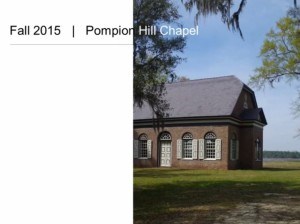
The greatest effort to unsilo the way students will look at this building in the upcoming IDC class, is by combining the history of building construction course with it's emphasis on investigation and the previous IDC course. Thus, Pompion will host landscape, architectural, and finish documentation and investigation, which has been the case with past IDC projects, but will also be examined in terms of construction methodology.
for example, following several course lectures on mason reconstruction, including terminology, brick making, bond patterns, the role of mortar within the assembly, students will hold part of a class section onsite at Pompion considering what they can learn about the building from the masonry physical evidence. In a guided observation and interpretation session, students will get practice applying their classroom learned skills to real world settings. Even more importantly, in particular to a building that they have already spent time looking at in great depth, as they take field measurements of it and consider it in its cultural landscape.
Other ideas for integration include, asking for an executive summary document from each student at the end of each semester. this summary will ask students to briefly discuss the meaning of the building, having students reflect on what the overall message is, and the take way from this multi pronged documentation and interpretation course will simulate the difficulty of having to synthesis the findings of a large thorough investigation, such as we encounter in professional practice.
Also towards the ends of exercising pattern finding, organizing, and distilling knowledge to finding meaning, we may instigate an additional final presentation to potential Clemson University collaborator to material scientists who work at the nearby Warren Lasch laboratory. In this exchange students would learn about the resources in this wonderful lab facility, and also share what they have learned about the case study building. We're excited about this potential in terms of students stretching and learning how to ask the next steps, or what else can we do.
Practice developing interesting research questions on a specific topic of interest builds general inquisitiveness, which we obviously care about, and also simulates the process many students encounter for the first time when they attempt to arrive at a thesis topic at the begging of their second year in the program.
As I mentioned easier on in the presentation, when channeling Carter, we are extremely welcoming of any of your thoughts and suggestions. The pedagogical rationale behind our documentation class which we are trying to push beyond drawing, where we're coming from and headed to, hopefully has sparked some of your thoughts on the topic. We look forward to being in touch with the panel, and thanks for your time and attention.
Last updated: April 7, 2025
